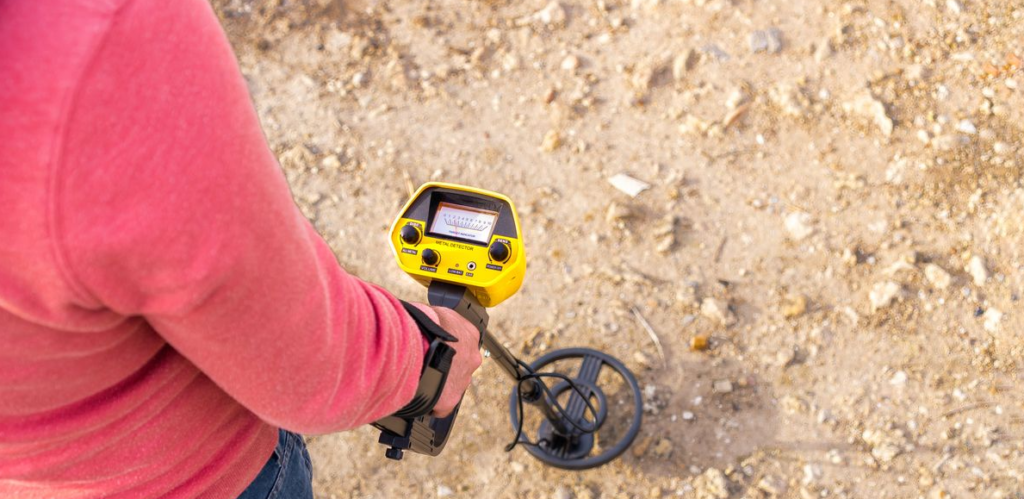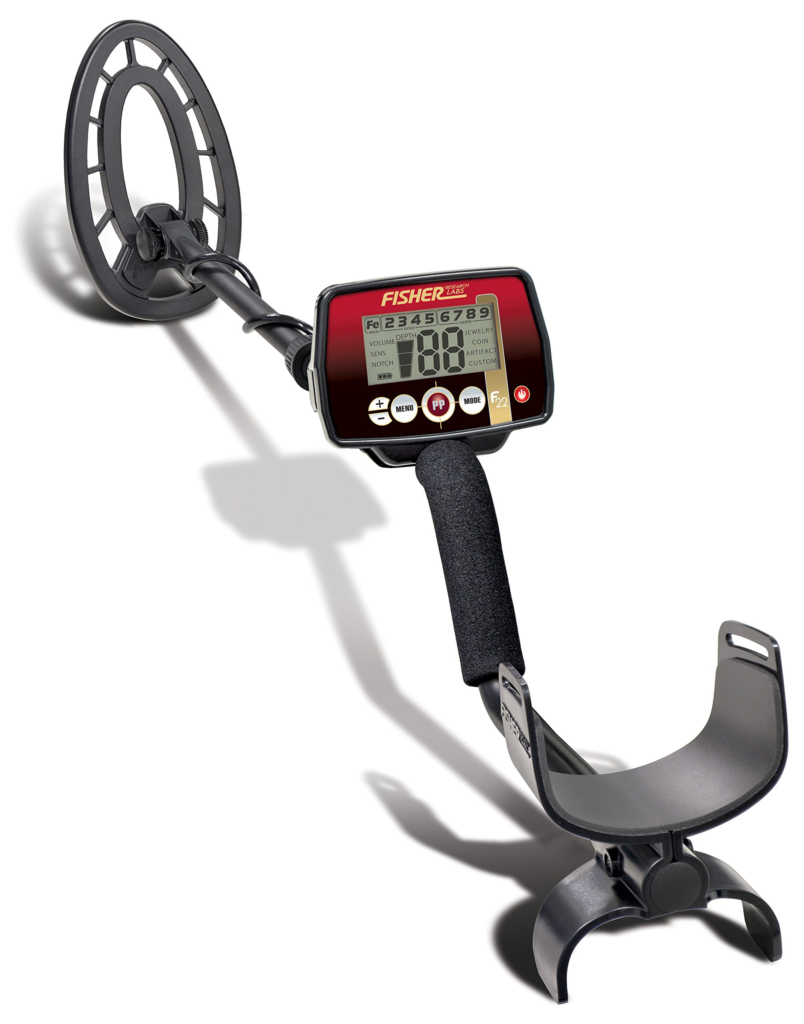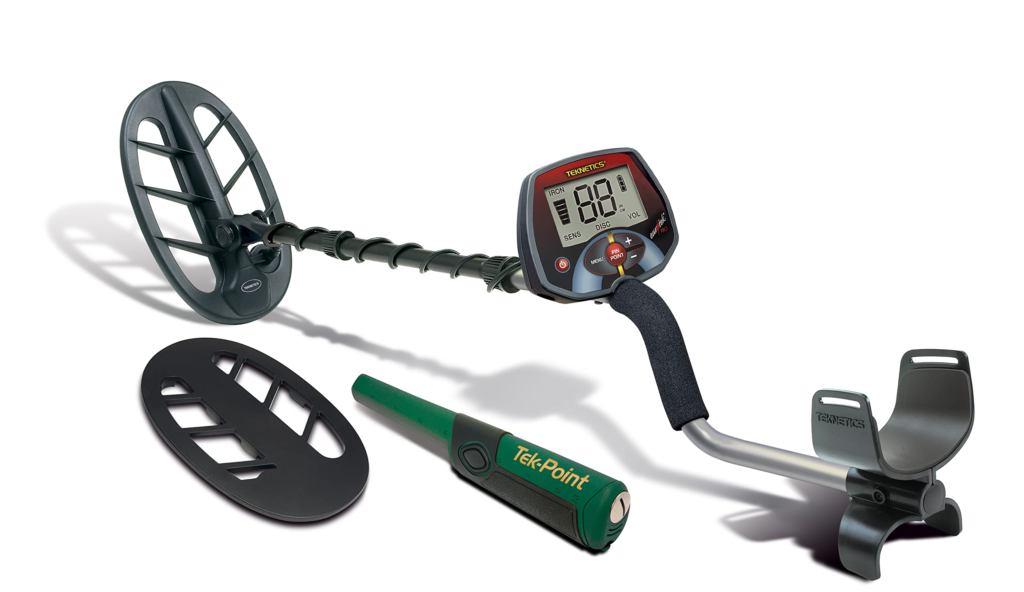
If you’re just starting on metal detecting, you don’t need to get fancy with your metal detector. Instead, you need a simple and frills-free detector that is easy to use and one that quite inexpensive.
Above all, you also need a detector that is performance-oriented, and, though it shouldn’t necessarily provide you with professional-grade performance, it should be at the very least functional.
However, finding a detector that meets all the above criteria can be quite a hassle, especially considering that you don’t have prior knowledge of metal detectors and how they work.
The good news is I’ve compiled a list of the top 5 metal detectors that are suitable for the beginners. The usage of these metal detectors is not limited to the beginners only, but some of this equipment is so good that they can even be used by seasoned treasure-hunters.
Here is my list of the top 5 beginner metal detectors:
1. Fisher F22 Metal Detector

The F22, released in 2015, is an upgrade to the F2, and it builds upon what its sibling offered. It comes with several enhancements such as a new coil design, iron audio, volume adjustment, and additional search modes. Even better, all these features are now housed in a smaller and compact weatherproof control box.
Design F22
weighs 2.3 pounds and from comparison, this is about 2X lighter than a majority of the metal detectors, and it means its a great option for beginners as it won’t weigh them down. Even better, I loved how it was well-balanced and durably constructed.
Coil Design
The F22 comes with a 9’ triangulated, elliptical concentric search coil that is narrow and perfect for picking out targets even in tight spaces like in between the rock.
Though the coil is submersible and can be used in shallow water, you should be cautious not to get the control box wet as its only weatherproof and not submersible.
Modes
F22 is quite a versatile metal detector, and we were impressed by the four search modes. Sure, it’s not the highest I’ve come across, but even so, it gives you the flexibility of tailoring your searches.
These four modes include:
- Jewelry mode for discriminating all iron targets
- Coin mode for discriminating all iron targets alongside other trash
- Artifact or relic mode is non-discriminatory and includes all iron signals
- Custom modes let you set a custom pattern using the notch feature
LCD Target ID Screen
F22 features an LCD Target ID Screen that displays a variety of indicators including:
- Target Category ID number that is quite handy in identifying the type of metal found
- Two-digit number target ID, which is a refinement of the Target Category and will give a better indicator of the metal found.
- The iron indicator helps to discriminate unwanted iron trash signals; we found this indicator suitable for jewelry and coin hunting.
- The target depth indicator gives you an estimate of how deep the target is.
Tones
For superior performance, this metal detector comes with four tones-bass, low, medium, and high, and when used alongside the numeric target, I found out that the F22 gives you a pretty good idea of the target in the ground.
While still at the tone, I was surprised to find out that the F22 features an Iron Audio, something that is not common in the entry-level indicators.
With the iron audio, I was able to amplify the iron signals, meaning I didn’t have to waste time digging trash, and I found this feature quite invaluable, especially when hunting for coin and jewelry as it saved me needleless hours of digging, not to mention the back pain.
Frequency
Coming in at a performance frequency of 7.96 kHz, F22 is certainly not one of the most sensitive metal detectors in the market, and this is not a surprise, especially considering this detector is an entry-level unit and a budget option.
Even so, most other users on the net are quite impressed by the deep and accurate targeting depth for this metal detector.
2. Minelab X-TERRA 305

Minelab X-TERRA 305 is yet another entry-level metal detector by Minelab, though it has several adjustments that could easily transform this detector into a professional-grade model.
Besides coming in with a lot of incredible features, one thing that I instantly noticed in this mode is the high gloss red finish with undertones of black. I
know aesthetics should not be a primary concern when looking for a metal detector, but I’ve to admit I was tempted to because this model is simply eye candy.
Design
From the word go, it’s evident that Minelab has designed this model with the beginners in mind. The assembly, for instance, has been kept nice and simple, and the few parts didn’t take me more than 5 minutes to assemble.
However, the weight is still higher than what I prefer, but I have to admit it doesn’t feel hefty either, and this is primarily because of the unique inverted design that takes the pressure off your wrist and gives you a comfortable experience, even when using the detector for extended periods.
True Digital VFLEX Technology (7 kHz & 18.75kHz)
A standout feature on this metal detector is VFLEX technology and a new class of single frequency that can be changed by the coil.
Contrary to other detectors where the operating frequency is a constant, Minelab’s frequency is dependent on the coil, and I found this quite an impressive feature since it increases your versatility of using this device, and more importantly, you could replace it for different purposes.
Sure, the standard coil might be a good fit for the all-purpose detecting, but I found this technology quite impressive for specialized treasure hunting.
Ground Balance
When purchasing a metal detector, one of the critical features that I usually consider is the ground balance, and it was a shame that the Fisher F22 I reviewed above didn’t come with this option.
With Minelab, however, I was treated to an easy-to-adjust ground balance function with a manual adjustment of 0-20 that allows you to adjust mineralization, meaning you could now work on the salty beaches or even in the high-mineralized grounds without interference.
Performance
Minelab is a premium model that comes with a gamut of features that promote ease of use and effective hunting. For instance, once you found an object, you can engage the PinPoint Recovery mode to assess the depth and exact spot before digging.
I also found the threshold adjustment, yet another handy feature as it allowed me to differentiate between the objects at different levels and size easily.
Noise Cancellation
The performance of this metal detector is further bolstered by three-tone IDs alongside a multi-tone ID that gave me greater flexibility in deciding how the tones are represented.
Even better, I was impressed by the noise cancellation function with three manual settings that will allow you to pick the quietest channel when detecting.
3. Garrett Ace 400

Garret has the best reputation when it comes to metal detector technology, and its for a good reason; they’re known to manufacture reliable metal detectors for at an affordable price.
The Garret Ace is probably one of the most popular Garret Series, and the Ace 400 is at the top of this line. The Ace 400 is an upgraded version of the now-discontinued Ace 350, and it comes with a host of new features including iron audio, digital target IS, cam locks, and adjustable frequency.
It’s perfect for the entry-level and mid-level metal detectorists who are looking forward to hunting all types of treasures, including gold nuggets, coins, jewelry, and relics.
Design
The Ace 400 is generally a lightweight machine, and at just 2.9 pounds, it doesn’t feel weighty, and you will generally have an easy time swinging the detector for an extended period.
However, what I really love about the design of this model is the adjustable stem alongside the cam lock that provides an extra eel of stability while swinging.
Even so, I found this detector quite unbalanced, mainly due to the large search coil, but fortunately, it doesn’t feel uncomfortable to use.
Frequency
Ace 400 is a VLF metal detector that comes with an operating frequency of 10 kHz, which is quite higher than the Ace 300 as well as a majority of the entry-level detectors.
I found this frequency quite sensitive to the smaller targets and medium-conductivity. Even better, the frequency strikes a balance between sensitivity and depth when coin and relic hunting, though it’s not suitable for gold prospecting.
Ground Balance
Contrary to the high-end models that come with both automatic and manual ground balance adjustment, Ace 400 comes with a pre-set ground balance.
For beginners, this isn’t a major issue, and having none is one less to think about; in any case, the Ace 400 performs excellently without the ground function.
Concerning the performance of this function, I really struggled while hunting in the mineralized surfaces, but to be fair, for this price point, I didn’t really expect a perfect ground balance adjustment.
Iron Audio and Discrimination
One of the unique features of Ace 400, at least in comparison with other Ace models, is the proprietary Iron Audio system that allows users to hear the discriminated iron targets so that they can adjust the signal range and pick up targets masked by iron.
Search Modes
Besides the pinpointing function, Ace 400 comes with five pre-set search modes for the ultimate flexibility.
The search modes include:
- Zero-Disc, which is similar to the all-metal mode but has a similar purpose of detecting every type of metal with no discrimination.
- Jewelry mode filter the majority of iron trash while targeting items such as rings, necklaces, and bracelets
- Relics mode eliminates smaller iron items and targets potentially lower conductivity targets such as items created from lead, bronze, and brass.
- Coins mode eliminates foil, pull tabs and the common trash to find coins
- Custom mode lets you program your notch discrimination pattern to eliminate segments that you don’t want to detect.
4. Teknetics EuroTek PRO

Teknetics EuroTek PRO is a budget machine, but from what I have found out, this metal detector has more than budget features, and in any case, it equals the power and performance of metal detectors the high-end metal detectors.
Ideally, this metal detector has been specially manufactured for beginner diggers, and they are a good option for coin shooters. Let’s see what this model has in store for us;
Frequency
EuroTek PRO is a VLF metal detector with an operating frequency of 7, 81 kHz, which offers a balance of sensitivity of depth.
The manufacturer, however, promotes this metal detector as a coin shooter, though I found out that a majority of this class of detectors operate in frequencies of 14 kHz.
Nonetheless, I can affirmatively say that I was impressed by the performance of this unit, and so were many of the users.
Search Modes
EuroTek PRO is quite a modest unit as it only comes with two search modes- dynamic and static, and this further underlines its suitability as a beginner metal detector.
Actually, the entire performance of this model is centered on a single program that lets users search using discrimination with three tone audio signal.
The good news, despite the simplicity of this model, I could easily exclude target from search range and even change the number of the audio tone.
The static search mode, also known as pinpointer, is ideal for the more target center location, while the dynamic mode, which is the basic mode, is suited for the general-type performance.
Discrimination
Featuring a linear discrimination scale, EuroTek PRO will allow you to exclude metal targets from the search range sequentially.
What I love the most about this feature are the 80 segments that made it possible to ignore even the smallest of the trash such as nails, caps, foil, and tab.
Sound
Using a rather simple setting that includes nice add-ons in its menu, this metal detector comes with convenient volume control that lets you distinguish your targets based on the level of sound generated.
5. Garret Ace 300

Sporting a utilitarian look, Ace 300 is a quality-built and easy to operate metal detector, an excellent companion for the novice ad mid-level treasure hunters.
It comes with a simplified interface, without being too overwhelming for the beginners, while still engaging enough for the seasoned hobbyists.
Digital Target ID
Even though Ace 300 comes with an audio mode function, it similarly has a Digital Target ID alongside a segment-based discrimination system for easier identification of the target.
The digital target ID has a numeral scale from 0-99, and this helps to indicate the conductivity of a target, with the higher the number, the higher the conductivity.
Adjustable Frequency
Few treasure hunters use this feature, but still, it's a convenient feature when you want to customize your search.
The Ace runs at 8 kHz, a standard frequency among many entry-level detectors, but it can be adjusted slightly, this metal detector is quite handy, especially when there was interference from power line/other signals, or even competing with other detectors.
Enhanced Iron
Resolution Ace 300 is a true upgrade to the 250, and one of the defining features of the upgrade is the greater number of “segments” which makes this model more adept at screening out the junk target and at the same time improving on the detector’s ability to separate trash targets from the good targets.
Search Modes
Typical of any quality metal detector, this model comes with a variety of search modes that help to improve o the overall flexibility and usage of the detector.
Thia metal detector has discrimination patters quite helpful, especially when you to limit your focus to specific types of targets. Like Ace 400, I reviewed earlier; this metal detector offers five search modes, which include; Jewelry, coins, relics, custom, and zero (no discrimination).
What to Look for in a Budget Beginner Metal Detector
In the section below, we will look at the critical factors that you need to consider when choosing the best metal detectors for beginners.
Ease of Use
Since you’re just starting, you should choose a simple and modest metal detector. Don’t go for anything fancy, but instead, choose a simple yet utilitarian model that is easy to handle.
Water-Resistant
You also need to consider the water capabilities of your detector, especially if you’re going to treasure hunt in the waters. For starters, you can go with a semi-waterproof detector, in the sense that it should not be completely waterproof, but the coil should be resistant to water.
Ground Balancing
Honestly, I wouldn’t really recommend that you choose a model with an automatic or manual ground balance point at this level.
In any case, most of the models that have adjustable ground balancing options are too expensive, come with a learning curve, and are sophisticated to use.
However, you can choose a model with pre-set ground balancing, but don’t expect it to provide the same performance to that of a full-sized metal detector.
Price
Yes, when testing the water, you don’t have to choose an expensive model, but rather go for the affordable and budget-option.
After all, you might find that you don’t have a knack for treasure hunting and you don’t want to get stuck with an expensive item in your garage.
Final thoughts on the Best Metal Detectors for Starters
Now, you have it; hopefully, this list has already provided you with inspiration on what model you should start your treasure hunting journey with. Whatever detector you choose, go with a model that will address all your treasure hunting needs.
